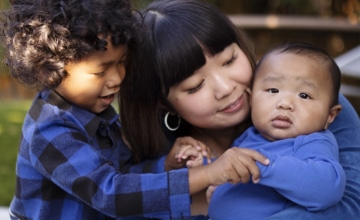The mission of Early Head Start is clear: to support healthy prenatal outcomes and enhance intellectual, social and emotional development of infants and toddlers to promote later success in school and life.
The science of early childhood development confirms that infancy and toddlerhood are times of intense intellectual engagement.1 During this time – a remarkable 36 months – the brain undergoes its most dramatic development, and children acquire the ability to think, speak, learn, and reason. All babies and toddlers need positive early learning experiences to foster their intellectual, social, and emotional development and to lay the foundation for later school success. Furthermore, babies and toddlers living in high-risk environments need additional supports to promote their healthy growth and development.
Disparities in children’s cognitive and social abilities become evident well before they enter Head Start or PreKindergarten programs at age four. Consequently, Early Head Start (EHS) was created with strong bipartisan support in the 1994 Head Start reauthorization to help minimize these disparities and ensure that children enter school ready to learn. It is the only federal program specifically designed to improve the early education experiences of low-income babies and toddlers. The mission of Early Head Start is clear: to support healthy prenatal outcomes and enhance intellectual, social and emotional development of infants and toddlers to promote later success in school and life.
On December 12, 2007, President Bush signed into law the reauthorization of the Head Start and Early Head Start programs (Public Law 110-134). Of particular significance is the fact that the reauthorization prioritized the expansion of Early Head Start, allocating half of all new expansion funding to Early Head Start. The law also allows for the conversion of preschool Head Start grants into Early Head Start grants based on local community needs and capacity. In addition, the law supports training and technical assistance for Early Head Start grantees, with at least 20 percent of all Head Start training dollars allocated to Early Head Start programs for training and technical assistance activities. This also includes a state-based training and technical assistance system staffed by specialists in infant and toddler development which will provide programs with valuable resources they can draw upon for continuous program improvement. Despite the significant gains achieved in the 2007 reauthorization, Early Head Start is reaching only a small proportion of at-risk children and families – only three percent of all eligible children and families are served.2
Research
The Congressionally-mandated Early Head Start Research and Evaluation Project – a rigorous, large-scale, random-assignment evaluation – concluded that Early Head Start is making a positive difference in areas associated with children’s success in school, family self-sufficiency, and parental support of child development. What is most compelling about the Early Head Start data is that they reflect a broad set of indicators, all of which show positive impacts – patterns of impacts varied in meaningful ways for different subgroups of families. Furthermore, a follow-up wave of research demonstrated that some of the positive impacts of participating in Early Head Start are still demonstrated two years later, as the Early Head Start children are entering kindergarten. In addition, the follow-up research examined the effects of Early Head Start in combination with pre-kindergarten education. Overall, (1) there were positive impacts remaining two years after the program ended, (2) some groups were faring particularly well, and (3) children who attended Early Head Start and pre-kindergarten between the ages of three and five experienced the most positive outcomes.
Intellectual, Social and Emotional Development
Effects of Early Head Start At Age Three:3
- Early Head Start Moves Children Further Along the Path that Could Lead to Greater School Readiness if the Early Head Start Gains are Maintained by Good-Quality Preschool Programs. Early Head Start produced statistically significant, positive impacts on standardized measures of children’s cognitive and language development.4 A smaller percentage of Early Head Start children (27.3 percent versus 32.0 percent) scored in the “at-risk” range of developmental functioning (although still below the mean of national norms). By keeping children from entering the lowest-functioning group, Early Head Start may be reducing the risk of later poor cognitive, language, and school outcomes.5
- Early Head Start Children Were More Attentive To Objects During Play with Their Parents Than Control Group Children. Play is important because being attentive to, and engaged in, play activities is how children begin to learn important cognitive and social skills needed for later school and life success.
- Early Head Start Children Had More Positive Interactions With Their Parents Than Control Group Children. Positive and secure parent-child relationships may reduce a young child’s fear in novel or challenging situations and enable the child to explore with confidence.6
Pre-Kindergarten Follow-Up Results:7
- Early Head Start Children Demonstrate More Positive Approaches To Learning Than The Children In The Control Group. In the preschool years, the EHS children liked to try new things, showed imagination in work and play, accepted friends’ ideas in sharing and playing, and wanted to hear that they were doing okay.
- Early Head Start Children Continue To Demonstrate Fewer Behavior Problems Than The Children In The Control Group. In the preschool years, the EHS children demonstrated fewer problem behaviors than their peers. Parents reported they were less likely to hit or fight with others, or be hyperactive or withdrawn than control group children.
- Early Head Start Children Were Significantly More Likely To Attend Formal Preschool Programs Than The Children In The Control Group. Those former EHS children who attended formal preschool programs received the benefits of both programs – enhanced early reading skills expected from preschool participation, but with less of the aggressive behavior sometimes associated with attending formal preschool programs. EHS may provide a protective factor when it comes to these behavior problems.
- Spanish-speaking Children In Early Head Start Showed Favorable Impacts On Their Vocabulary. Early Head Start supported the development of these children’s Spanish vocabulary compared to the Spanish-speaking children in the control group. These gains help build a strong foundation for language development
Parenting and Families
Effects of Early Head Start At Age Three:8
- Early Head Start Parents Were More Involved and Provided More Support for Learning. EHS programs have significant favorable impacts on a range of parenting outcomes. EHS parents were observed to be more emotionally supportive and less detached than control-group parents. They also provided significantly more support for language and learning than did the control-group parents.
- Early Head Start Had A Favorable Impact on Child-Father Interactions. Early Head Start significantly improved how fathers interacted and related to their children. EHS children were observed to be more able to engage their fathers and to be more attentive during play than control group children. EHS fathers were observed to be less intrusive in interacting with their children than control group fathers. The emotional quality of the father-child relationship appears to be extremely important to children’s adjustment and well-being.9
Pre-Kindergarten Follow-Up Results:10
- Early Head Start Parents Continued To Support Their Children’s Learning Two Years Later. These parents were more likely to read to their children every day and came up with learning activities such as pre-math or pre-reading games on their own. They thought about whether materials available in the home were developmentally appropriate. EHS parents were more likely to be involved in their child’s formal preschool settings, including events such as parent open houses.
- Home-based Programs Produced More And Stronger Results On Both Children And Families At Age Five. Parents were more likely to have reached self-sufficiency with higher monthly incomes. The home environment offered more learning activities. The children had better social and math skills and fewer behavior problems.
- Former Early Head Start Parents Experienced A Reduced Risk Of Parental Depression. At enrollment, and at age three, there had been a high level of maternal depression in both the EHS and control groups. Early Head Start did not have an immediate impact on the depressive symptoms, but did have positive impacts on the parent-child interactions of depressed parents. And two years after the end of the program, former EHS parents report fewer symptoms of depression. Generally, depression makes it difficult for parents to respond to their children, causing difficulties in the child’s social-emotional development and learning.
- Effects Of Participating In Early Head Start Were Different For Families With Different Characteristics. Among the highest risk families, some favorable impacts on children’s social-emotional development, parenting, and the home environment emerged that had not been seen at age three. Children in families at high levels of demographic risk who attended Early Head Start and Head Start (a comprehensive pre-kindergarten program including family services) fared particularly well. Impacts for low and moderate risk groups were sustained over the two years. When impacts are examined by race/ethnicity, African-American children continue to show the greatest benefits of Early Head Start. African-American children were particularly likely to be enrolled in formal programs following Early Head Start.
Study Design
The scientific design for the Early Head Start Research and Evaluation Project was rigorous and conservative in drawing conclusions from their findings. Differences in research designs make it difficult to compare other well-respected national intervention studies to the Early Head Start evaluation. Differences include:
- The Early Head Start Research and Evaluation Project used a much larger and more diverse research sample. Both waves of the Early Head Start Research and Evaluation Project were based on a large research sample – over 3,000 families. Other studies, such as the Abecedarian Project and the Nurse Home Visitation Program studies, had much smaller samples for their studies – 111 children were part of the Abecedarian study and 400 mothers were involved in the Nurse Home Visitation Program. Early Head Start produced positive outcomes over a much greater scale with a more diverse population.
- The Early Head Start Research and Evaluation Project covered a more specific period of time. The Administration on Children, Youth and Families designed a thorough and rigorous random-assignment evaluation to examine the impacts of Early Head Start on child and family outcomes when the children were 14, 24, and 36 months old. In the follow-up results, released in April of 2006, those same children had been assessed again prior to kindergarten entry at an average age of 63 months or just over five years of age. The Abecedarian Study followed children through age 21 and the Nurse Home Visitation Program followed children through age 15. Although the Early Head Start follow-up results continued to show positive impacts two years later, until further longitudinal studies are conducted, we have no way of assessing what it takes to sustain impacts made by Early Head Start later in life and to understand “sleeper effects” (i.e. how Early Head Start may influence other unintended effects in young adulthood such as delinquency, teen pregnancy, and high school dropout rates).
- The Impact of Early Head Start may be even greater than data show. The control group of the Early Head Start Research and Evaluation Project is not a “non-treatment” control group. Although they did not receive any Early Head Start services, children in the control group were permitted to receive other services in the community. The control group of the Abecedarian Study on the other hand, was a non-treated control group.11 A non-treated control group gives researchers greater confidence that differences between the treated and untreated individuals can be credited to the early childhood intervention.12 Since the children of the EHS control group were permitted to receive other kinds of community services, it is likely that the impact of Early Head Start may be even greater than the date shows.
Citations
1 Shonkoff, Jack and Phillips, Deborah. 2000. From neurons to neighborhoods: The science of early childhood development. Washington, DC: National Academy Press.
2 Note: 61,243 is the exact number of children under three served by Early Head Start in Fiscal Year 2005. Head Start Program Information Report for the 2004-2005 Program Year, Early Head Start Programs Only. Retrieved October 23, 2006. Note: 2,552,000 children under three in the U.S. live below the federal poverty level. U.S. Census Bureau. 2005. Current population survey, 2006 annual social and economic supplement. POV 34: Single year of age—Poverty status: 2005. (accessed January 22, 2018).
3 U.S. Department of Health and Human Services, Administration for Children and Families. 2002. Making a difference in the lives of infants and toddlers and their families: The impacts of Early Head Start. (accessed January 22, 2018).
4 Ibid.
5 Ibid.
6 Shonkoff, Jack and Phillips, Deborah. 2000. From neurons to neighborhoods: The science of early childhood development.
7 U.S. Department of Health and Human Services, Administration for Children and Families. 2006. Research to practice: Preliminary findings from the Early Head Start prekindergarten followup. (accessed January 22, 2018).
8 U.S. Department of Health and Human Services, Administration for Children and Families. 2002. Making a difference in the lives of infants and toddlers and their families: The impacts of Early Head Start.
9 Ibid.
10 U.S. Department of Health and Human Services, Administration for Children and Families. 2006. Research to practice: Preliminary findings from the Early Head Start prekindergarten followup.
11 The Carolina Abecedarian Project. Early learning, later success: The Abecedarian study executive summary. http://fpg.unc.edu/node/4038 (accessed January 22, 2018). 12 Ibid.



